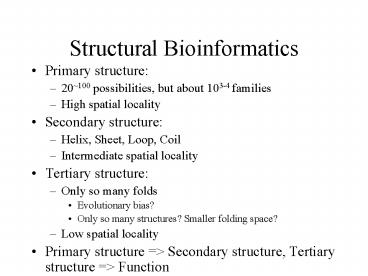Structural Bioinformatics PowerPoint PPT Presentation
1 / 12
Title: Structural Bioinformatics
1
Structural Bioinformatics
- Primary structure
- 20100 possibilities, but about 103-4 families
- High spatial locality
- Secondary structure
- Helix, Sheet, Loop, Coil
- Intermediate spatial locality
- Tertiary structure
- Only so many folds
- Evolutionary bias?
- Only so many structures? Smaller folding space?
- Low spatial locality
- Primary structure gt Secondary structure,
Tertiary structure gt Function
2
Structural Bioinformatics
- Macromolecular complex gt
- Protein gt (No. of species 104)
- Fold gt (103)
- Domain gt (103-4)
- Module gt
- Motif gt
- Residue gt
- Atom
Level of abstraction
3
Primary structure
- Determined
- Experimentally
- Sequencing
- Computationally
- Proteome prediction from genome
- Finite number of real-world families based on
sequence similarity - Significance Sine qua none
- Databases Swiss-Prot, PIR, Genpept
4
Secondary structure
- Determined
- Experimentally
- Circular dichroism, NMR, Raman spectroscopy
- Computationally
- Sliding window context analysis
- Periodicity analysis
- Significance
- Higher order building block
- Mechanistic significance in protein folding
5
Tertiary structure
- Determined
- Experimentally
- X-ray crystallography, NMR
- Computationally
- Based on similarity to known structures (Homology
modeling) - a priori
- Significance
- Level of abstraction highly indicative of
function - Databases PDB, SCOP, CATH, FSSP
6
Structural representation
- Average (crystallography) or set (NMR) of
structures specified - Cartesian coordinates (x,y,z) for each atom in
structure One vector for each atom - Internal coordinate representation (edges,
angles) Set of inter-atom vectors
7
Comparing structures
- Align structures
- Exhaustive search space vast (Complexity?)
- Algorithms typically use subset of coordinates
- Compute similarity
- Root mean square deviation
- Other normalized measures
8
Structural alignment
- Vector based strategies
- Compare summarized vector representations (VAST)
- Compare nearest-neighbor vectors (SSAP) by
dynamic programming - Distance matrix comparisons (a là Dot-matrix)
- Subset of internal coordinate space (DALI)
9
VAST alignment
- Use only subset of atom coordinates
- Replace atom coordinates with vector coordinates
corresponding to secondary structural elements - Compare sets of vectors to assess similarity
10
Double dynamic programming
- First level
- Represent each residue by neighborhood vector
- Compare n versus m neighborhood vectors
- Generate optimal alignment based on vector
differences and dynamic programming - Second Level
- Add matrix scores if paths cross in a cumulative
matrix - Generate optimal alignment based on the
cumulative matrix
11
Distance matrix based alignment
- Generate dot-matrix of inter-residue distances,
using threshold - Pick out secondary structure elements based on
matrix patterns - Compare two matrices to generate structural
alignment
12
Summary
- Sequence similarity (gt 50 identity) implies
structural similarity. Converse not necessarily
true (evolutionary convergence/information
convergence) - Structural similarity algorithms are heuristic
ways to assess structural similarity
independent of sequence similarity - Structural variation is smaller that the number
of possible sequences

